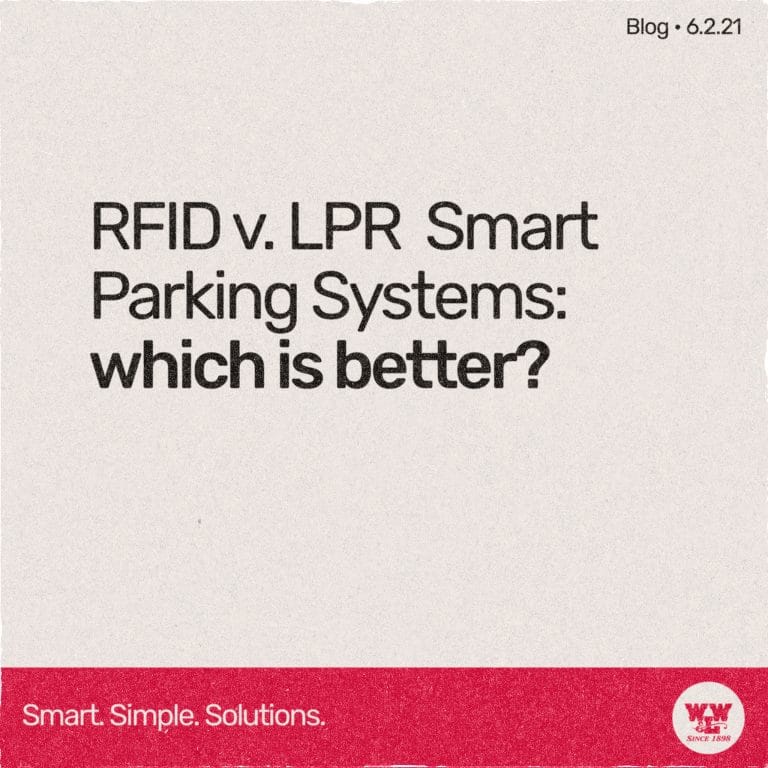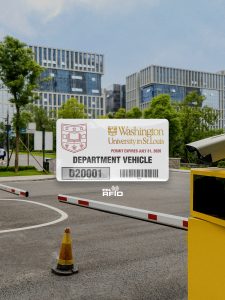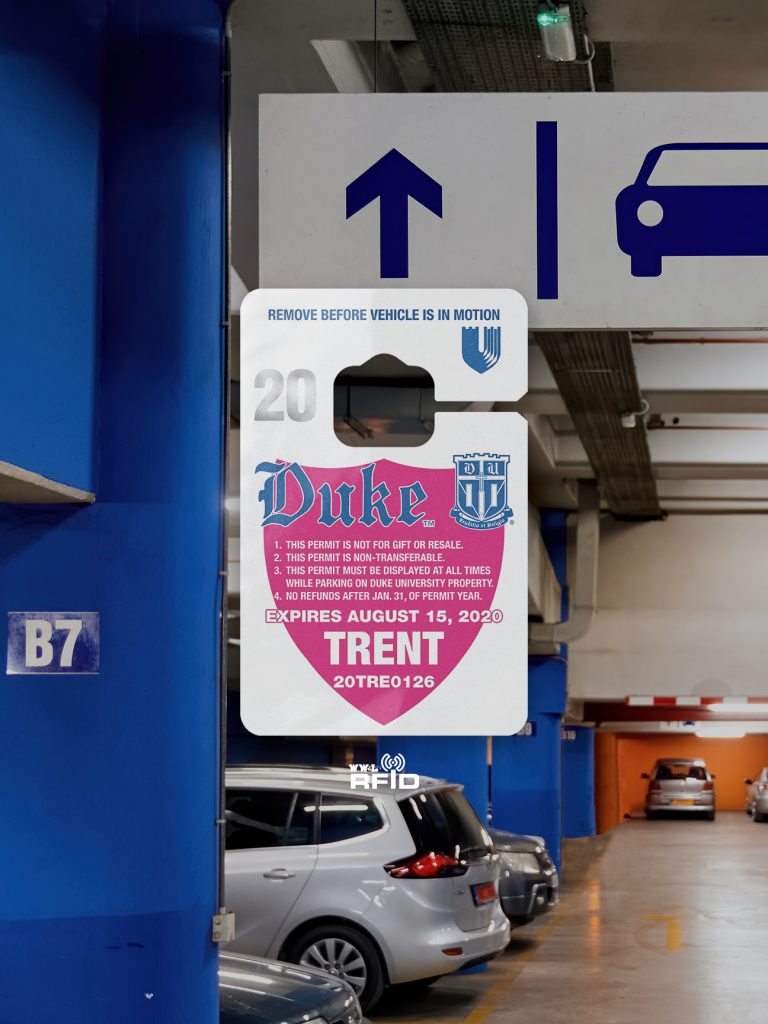RFID vs LPR Smart Parking Systems: Which is Better?
Parking lot operators have two main choices for automated, smart parking systems: RFID and license plate readers (LPR, but you may also see them referred to as ANPR).
We’ll lay our cards out up front: we’re an RFID company! so of course we’re going to come down on the side of RFID. If you already trust us, that’s great. If not, we think we can fairly lay out the pros and cons of RFID and LPR parking control systems, and let you decide which would work best for your needs.
How does RFID and LPR vehicle access work? (very briefly)
RFID access control systems work the same for cars as they do for individuals. The facility places an RFID reader at the access point and each user has a credential that communicates with the reader to grant access.
License plate readers are just what they sound like. A camera system is installed at the access point that “reads” the license plate, compares the result to a database of authorized vehicles and grants access accordingly.

Accuracy shapes security and convenience of smart parking systems
Any access control system has to satisfy two major demands: security and convenience. Venues, buildings or parking lot managers have to strike a balance between the two, even as technology is steadily eliminating the trade-off and providing the necessary amount of both.
The accuracy of a smart parking system feeds into both factors. If a system is overly permissive, it will grant access to unauthorized personnel. If its errors tilt towards more caution, you’ll have angry customers or clients, and potentially a traffic jam at your access points. Think of it as a question of false positives vs. false negatives. Most systems will “fail negative,” because those create issues of customer experience and satisfaction rather than security, which carries greater risk and liability.
LPR systems are much less accurate than RFID systems. The most-cited studies report a 4% error rate. If a parking lot holds 500 cars, and you scan them on the way in and out, that’s potentially 40 annoyed customers every day.
However, most of the research into LPR accuracy comes from highway usage, such as toll cameras. Those cars can be travelling over 65 mph, which introduces a source of error. Cars entering or leaving a parking lot – even ones that do not have a gate – will be moving much more slowly, which reduces the error rate.
Another source of inaccuracy when outdoors is the environment. Heavy rain, snow, dense low fog or even the glare of the sun can obscure the camera’s view of the license plate.
This is not a concern for an indoor parking lot, and is less of a concern for an outdoor parking lot since the distance between the camera and the license plate is so much smaller. But the license plate can still be obscured by snow or mud, which would limit any LPR camera’s ability to read it. Your customers and tenants will not want to have to get out of their car and wipe off their license plate at the end of an already trying commute.
RFID systems are insensitive to weather or the distances we’re talking about. RFID tags or decals go on one of the car windows. If they are obscured by snow or dirt, well, the driver has other things to worry about.
RFID systems also have an internal error-check that LPR systems do not have.
License plate recognition uses visual recognition algorithms built on machine learning. They do not actually “recognize” the letters and numbers on a license plate. Visual recognition systems compute the relative probability that what they “see” is one of the shapes in their system. It’s as if the algorithm is saying: “There’s a 97% chance that’s a G, a 92% chance that’s a Q, an 81% chance that’s a C… a .05% that’s a 7. OK, we’re going with G!” for each character. These systems have no way of verifying their output. At best, they can have multiple independent cameras and algorithms, but even then, it just comes down to taking the highest ranked guess.
RFID control systems have a check code that verifies the quality of the data they receive from a sensor. They can determine whether they made a “good read” or a “bad read.” If it’s a bad read, they keep reading until they get a good transmission (e.g., the driver moves closer to the sensor) or they send an error message because it’s a false credential.
As long as the system makes a good read and that RFID tag is in the system, it’s accurate.
License plate recognition relies on what cars already have
LPR-based vehicle tracking systems take advantage of something every car already has: license plates. Parking lot operators do not need to issue anything to their users. They only need to know each car’s license plate, which is a standard piece of information collected during employee onboarding, student orientation or parking pass registration.
Parking lots using RFID need to issue each car an RFID tag or decal. This adds to the expense of an RFID system, both in terms of equipment and manpower: someone needs to be there to issue all those tags, whether that’s in-person at the parking lot office or stuffing them into the welcome package.
RFID allows transferring access from car to car (for better or worse)
Transferability might be the biggest flashpoint between security and convenience.
License plates are obviously not transferable (not legally, at least). LPR access systems guarantee that the only cars in your parking lot are the cars allowed in your parking lot.
But it’s really not about the cars, right? It’s about the people.
If an employee wakes up one morning and her car doesn’t start, or if he got into an accident the night before, they might have to drive someone else’s car: spouse, roommate, rental. But that car won’t be able to get onto the lot, even though the driver comes there every day. Having to park out in the guest lot (and pay the guest rate!) is going to make an already bad day even worse.
Depending on the RFID system you choose, you may or may not encounter the same thing. RFID credentials can be a decal that go on the windshield. These are as “car locked” as a license plate.
However, you can also go with RFID hang tags or a removable unit like New York’s E-ZPass. If a customer is unable to drive their usual car, they can take one of these windshield tags into their substitute car. Seamless for them, and the same level of security and access control for you: the access goes with the person, not the vehicle.
Of course, the access can also go with the wrong person. Customers may let their friends borrow their parking pass for the day, or the pass may get stolen. Either way, unauthorized personnel can now enter your facility without your knowledge because you only know about the car they drove, not who drove it. Obviously, a stolen car can enter any place that it is registered with an LPR system. But cars tend to be noticed and reported as stolen much sooner than parking tags.
RFID has the edge over LPR for smart parking lots
Did we do it? Did we present an even case for and against both RFID and license plate recognition parking access controls? You tell us.
No, really, tell us! Let us know either way by dropping us a line or calling us, and we’ll be happy to talk in more detail about smart parking systems and how WW&L can help upgrade yours.




